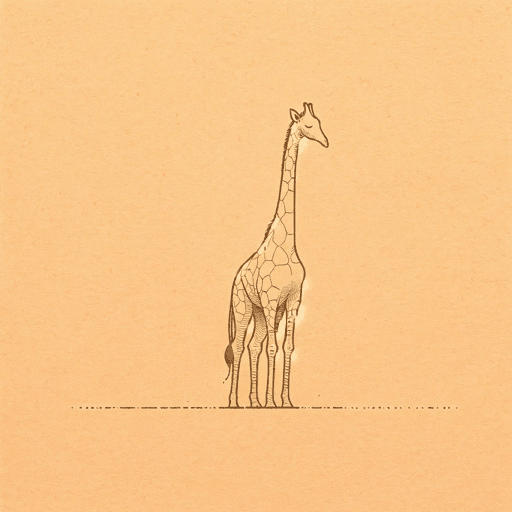67 pages • 2 hours read
Lynda RutledgeWest with Giraffes
Fiction | Novel | YA | Published in 2021A modern alternative to SparkNotes and CliffsNotes, SuperSummary offers high-quality Study Guides with detailed chapter summaries and analysis of major themes, characters, and more. For select classroom titles, we also provide Teaching Guides with discussion and quiz questions to prompt student engagement.
Summary and Study Guide
Overview
West with Giraffes by Lynda Rutledge tells the great adventure story of 17-year-old Woodrow Wilson Nickel, who drives two giraffes cross-country in 1938 America, finding himself along the way through the joys and conflicts of the voyage. This novel is a piece of historical fiction and a bildungsroman, in which the historical context of 1938 permeates the narrator’s character development. Told through the first-person narrative point-of-view of the protagonist, Rutledge engages her reader in a story of adventure and an homage to animal rights. Central to this story is the promotion of animals as worthy of human devotion. Inspired by a true story, this novel is about hope, resilience, love, and the importance of memory and storytelling. West with Giraffes was published in 2021 and has been translated into 20 different languages.
Plot Summary
In 1938, an enormous hurricane hits New York, killing people and upending ships. A 17-year-old named Woodrow, newly arrived from the Dust Bowl (the Southern Plains region of the US, affected by severe drought at the time), watches in awe as two giraffes are brought to the harbor amid the storm. Woodrow instantly falls in love with the giraffes and decides to follow them on their journey to California, where Woodrow has heard there are rich new opportunities. Woodrow follows the giraffe rig through two states, until the driver of the rig runs away, spooked by a kick from the giraffes. Woodrow convinces Riley Jones, the man in charge of the giraffes, to let him drive the rig. Constantly on Woodrow’s mind is his burgeoning friendship with Augusta “Red” Lowe, a beautiful young journalist from New York who wants to complete a photo-essay of the giraffes’ voyage.
Woodrow drives the rig and encounters many challenges. The road is a challenge, with treacherous mountain driving, small bridges, and constant traffic threatening the well-being of the rig. Throughout his journey, Woodrow encounters conflict characteristic of the time period. There is the major conflict between Riley and Percival, who owns the traveling circus. Percival is an animal abuser who attempts to buy and steal the giraffes for his own financial gain. The lack of animal rights laws and Percival’s financial monopoly ensures that the only people who can fight off Percival are Woodrow and Riley. However, Woodrow is seduced by Percival’s offer of a fortune, and Woodrow must make the decision to forgo financial security and risk his future for the giraffes, a choice he makes despite his trauma. Woodrow also witnesses the oppressive racism of the time period. When their rig’s tires blow out underneath a tight underpass, Woodrow and Riley must rely on the hospitality of a segregated Black community. His casts aside his initial discrimination toward Black people after he realizes that the family, the Jacksons, are hospitable, kind, and helpful.
Woodrow’s relationship with Riley is tested when Woodrow accepts money from Percival. Ultimately, Riley forgives him, demonstrating Riley’s deep capacity for empathy. Because of the struggles of the journey and Woodrow’s clear connection with the giraffes, Riley keeps him on for the trip to California. However, this voyage includes passing through the Panhandle, an area Woodrow is scared to return to because the law is looking for him and because of the traumatic memories the Panhandle evokes for him.
Throughout their journey, they are followed by Red, who is determined to make her photo-essay a success. Woodrow discovers that police enforcement is looking for Red; she is wanted as a runaway wife and thief of a stolen vehicle. Red’s quick but meaningful conversations with Woodrow keep him in her trance, but they also inspire him to do well by Riley and the giraffes.
As Woodrow faces his biggest fear of traveling through the Panhandle, he reveals his traumatic story to Riley: An argument with his father over killing the farm’s horse led to a shootout between Woodrow and his father, as well as his father’s suicide. For this, Woodrow worries that the country sheriff is after him. Woodrow also feels guilt over the demise of his family. Riley encourages Woodrow to let go of his guilt and embrace his future.
As they drive, more conflicts arise. Another fight ensues between Woodrow, Riley, and a man who wants one of the giraffes. Red discovers she is pregnant. Then, a flash flood in Texas threatens their lives. Red saves the rig from the flood by sacrificing her car and belongings, including her treasured photographs. Red has no choice but to return to her husband.
Woodrow and Riley finally reach San Diego, but Woodrow is desperate to rejoin Red before she makes it back East. On his way to Phoenix to find her at the train station, Woodrow is stopped by the police who suspect him of stealing. They give him a choice: Choose the army or choose prison.
Woodrow serves in World War II for seven years. When he returns from the war, he looks up Red and discovers that she died shortly after giving birth to a daughter. Then, Woodrow returns to the San Diego Zoo, where he discovers that Riley has passed away, but the giraffes are thriving. Woodrow gets a job as a grave digger, which frees up his days to visit the giraffes. Woodrow lives a long life in which all his loved ones die before him. In his old age, he resolves to tell Red’s story to her daughter. When Woodrow dies, a Veterans Affairs liaison finds his written notes and sends them to Red’s daughter.

